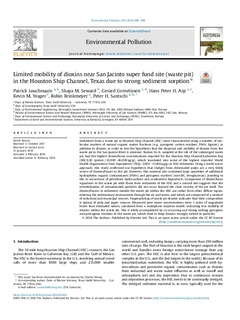| dc.contributor.author | Louchouarn, Patrick | |
| dc.contributor.author | Seward, Shaya M. | |
| dc.contributor.author | Cornelissen, Gerard | |
| dc.contributor.author | Arp, Hans Petter Heinrich | |
| dc.contributor.author | Yeager, Kevin M. | |
| dc.contributor.author | Brinkmeyer, Robin | |
| dc.contributor.author | Santschi, Peter H. | |
| dc.date.accessioned | 2018-09-03T14:05:33Z | |
| dc.date.available | 2018-09-03T14:05:33Z | |
| dc.date.created | 2018-03-05T11:18:39Z | |
| dc.date.issued | 2018 | |
| dc.identifier.citation | Environmental Pollution. 2018, 238 988-998. | nb_NO |
| dc.identifier.issn | 0269-7491 | |
| dc.identifier.uri | http://hdl.handle.net/11250/2560568 | |
| dc.description.abstract | Sediments from a waste pit in Houston Ship Channel (HSC) were characterized using a number of molecular markers of natural organic matter fractions (e.g., pyrogenic carbon residues, PAHs, lignins), in addition to dioxins, in order to test the hypothesis that the dispersal and mobility of dioxins from the waste pit in the San Jacinto River is minimal. Station SG-6, sampled at the site of the submerged waste pit, had the highest dioxin/furan concentrations reported for the Houston Ship Channel/Galveston Bay (HSC/GB) system (10,000e46,000 pg/g), which translated into some of the highest reported World Health Organization Toxic Equivalents (TEQs: 2000e11,000 pg/g) in HSC sediments. Using a multi-tracer approach, this study confirmed our hypothesis that sludges from chlorinated pulps are a very likely source of dioxins/furans to this pit. However, this material also contained large quantities of additional hydrophobic organic contaminants (PAHs) and pyrogenic markers (soot-BC, levoglucosan), pointing to the co-occurrence of petroleum hydrocarbons and combustion byproducts. Comparison of dioxin/furan signatures in the waste pit with those from sediments of the HSC and a control site suggests that the remobilization of contaminated particles did not occur beyond the close vicinity of the pit itself. The dioxins/furans in sediments outside the waste pit within the HSC are rather from other diffuse inputs, entering the sedimentary environment through the air and water, and which are comprised of a mixture of industrial and municipal sources. Fingerprinting of waste pit dioxins indicates that their composition is typical of pulp and paper sources. Measured pore water concentrations were 1 order of magnitude lower than estimated values, calculated from a multiphase sorption model, indicating low mobility of dioxins within the waste pit. This is likely accomplished by co-occurring and strong sorbing pyrogenic and petrogenic residues in the waste pit, which tend to keep dioxins strongly sorbed to particles. | nb_NO |
| dc.language.iso | eng | nb_NO |
| dc.publisher | Elsevier | nb_NO |
| dc.rights | Navngivelse 4.0 Internasjonal | * |
| dc.rights.uri | http://creativecommons.org/licenses/by/4.0/deed.no | * |
| dc.title | Limited mobility of dioxins near San Jacinto super fund site (waste pit) in the Houston Ship Channel, Texas due to strong sediment sorption | nb_NO |
| dc.type | Journal article | nb_NO |
| dc.type | Peer reviewed | nb_NO |
| dc.description.version | publishedVersion | nb_NO |
| dc.source.pagenumber | 988-998 | nb_NO |
| dc.source.volume | 238 | nb_NO |
| dc.source.journal | Environmental Pollution | nb_NO |
| dc.identifier.doi | 10.1016/j.envpol.2018.02.003 | |
| dc.identifier.cristin | 1570436 | |
| dc.relation.project | Norges forskningsråd: 231736 | nb_NO |
| dc.description.localcode | © 2018 The Authors. Published by Elsevier Ltd. This is an open access article under the CC BY license (http://creativecommons.org/licenses/by/4.0/). | nb_NO |
| cristin.unitcode | 194,0,0,0 | |
| cristin.unitname | Norges teknisk-naturvitenskapelige universitet | |
| cristin.ispublished | true | |
| cristin.fulltext | original | |
| cristin.qualitycode | 1 | |

